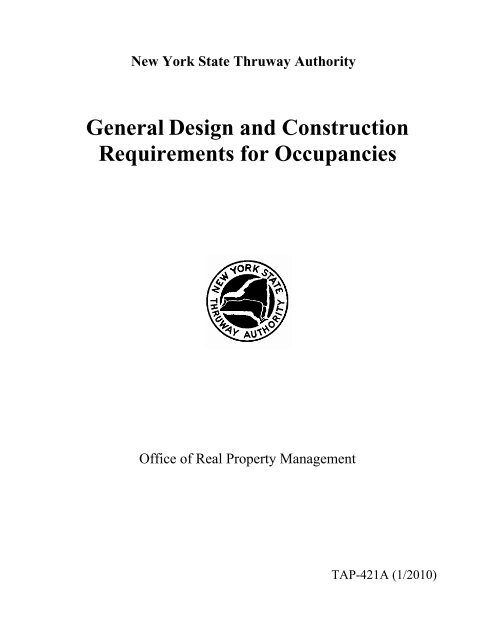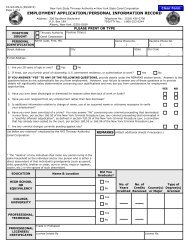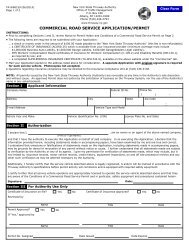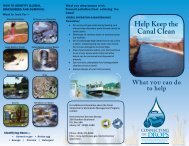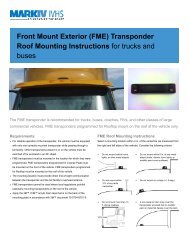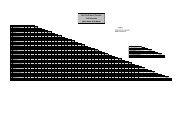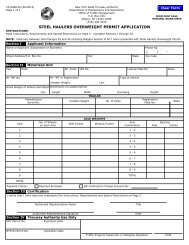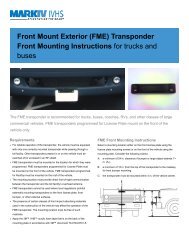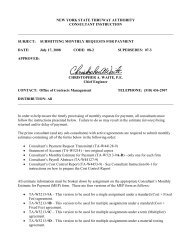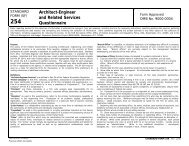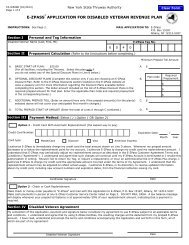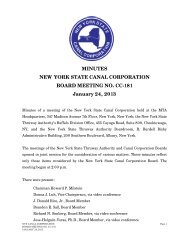TAP-421A: General Design and Construction Requirements for ...
TAP-421A: General Design and Construction Requirements for ...
TAP-421A: General Design and Construction Requirements for ...
Create successful ePaper yourself
Turn your PDF publications into a flip-book with our unique Google optimized e-Paper software.
New York State Thruway Authority<strong>General</strong> <strong>Design</strong> <strong>and</strong> <strong>Construction</strong><strong>Requirements</strong> <strong>for</strong> OccupanciesOffice of Real Property Management<strong>TAP</strong>-<strong>421A</strong> (1/2010)
SUBMIT PERMIT APPLICATIONS TO THE APPROPRIATE THRUWAYAUTHORITY DIVISION PERMIT COORDINATORDIVISIONNew YorkHIGHWAY SECTIONSNew York (Main Line)- Garden State ParkwayConnection- New Engl<strong>and</strong> Section- I-287 Cross WestchesterDIVISION MILEPOSTLIMITS0.00 - 76.50G.S. 0.00 - G.S. 2.40N.E. 0.17 - N.E. 15.01C.W.E. 0.00 - C.W.E. 10.90AlbanyAlbany (Main Line)- Berkshire Section76.50 - 197.90B. 0.00 – B. 24.28Syracuse Syracuse (Main Line) 197.90 - 350.60BuffaloBuffalo (Main Line)- Niagara Section350.60 - 496.00N. 0.00 - N. 21.50TELEPHONETELEPHONE NUMBERS AND ADDRESSESADDRESSOccupancy <strong>and</strong> Work Permit Program Mgr.Office of Real Property ManagementAdministrative Headquarters(518) 436-2797, Fax (518) 471-4442NY Division Permit Coordinator(845) 918-2510, Fax (845) 918-2596Albany Division Permit Coordinator(518) 436-2710, Fax (518) 436-0233Syracuse Division Permit Coordinator(315) 437-2741, Fax (315) 461-0765200 Southern BoulevardP.O. Box 189Albany, NY 12201-01894 Executive BoulevardSuffern, NY 109019W, Interchange No. 23P.O. Box 861Albany, NY 12201-0861Suite 250, 2 nd floor290 Elwood Davis RoadSyracuse, NY 13088-2103Buffalo Division Permit Coordinator(716) 631-9017, Fax (716) 626-5362455 Cayuga Road, Suite 800Cheektowaga, NY 14225NOTE: For the Cross Westchester Expressway (I-287), Occupancy Permits are issued by theNew York State Department of Transportation <strong>and</strong> Work Permits are issued by the NewYork State Thruway Authority.
TABLE OF CONTENTSSECTIONPAGEI. INTRODUCTION .........................................................................................................1II. DEFINITIONS...............................................................................................................2III. GENERAL CONSTRUCTION REQUIREMENTS .....................................................3A. STATEMENT OF REQUIREMENT ......................................................................3B. PRIOR INSPECTION..............................................................................................3C. ACCESS ..................................................................................................................3D. ENVIRONMENTAL REQUIREMENTS ...............................................................4E. EXCAVATION/OBSTRUCTION ..........................................................................4F. BLASTING..............................................................................................................8G. TRENCHES.............................................................................................................8H. RESTORATION......................................................................................................9I. MAINTENANCE AND PROTECTION OF TRAFFIC..........................................9J. NOTICE OF JOB SCHEDULE AND FINAL INSPECTION ...............................11K. TEMPORARY CONCRETE BARRIER PROTECTION AT ROADSIDEHAZARDS.............................................................................................................11IV. DESIGN REQUIREMENTS FOR INSTALLATIONS..............................................13A. MINIMUM REQUIREMENTS.............................................................................13B. MATERIALS.........................................................................................................14C. EXPANSION OF FACILITIES.............................................................................14V. LAND SURVEYS .......................................................................................................15i
I. INTRODUCTIONThe <strong>General</strong> <strong>Design</strong> <strong>and</strong> <strong>Construction</strong> <strong>Requirements</strong> <strong>for</strong> Occupancies (<strong>TAP</strong>-<strong>421A</strong>)(<strong>General</strong> <strong>Requirements</strong>) provides the general construction requirements <strong>for</strong> anyoccupancy of Authority Property.These <strong>General</strong> <strong>Requirements</strong> are to be used in conjunction with the guidelines governingthe issuance of Permits as set <strong>for</strong>th in the Occupancy <strong>and</strong> Work Permit AccommodationGuidelines (<strong>TAP</strong>-401) <strong>and</strong>, if applicable, with the guidelines governing Utilityoccupancies as set <strong>for</strong>th in the Utility Occupancy Supplement (<strong>TAP</strong>-401U).Copies of the most current <strong>General</strong> <strong>Requirements</strong> may be obtained from the DivisionPermit Coordinators or from the Real Property section of the Authority’s website(www.nysthruway.gov/realproperty). In<strong>for</strong>mation pertaining to or interpretation of thecontents of these <strong>General</strong> <strong>Requirements</strong> may be obtained by visiting, writing, faxing ortelephoning the Authority locations listed on the inside front cover of these <strong>General</strong><strong>Requirements</strong>.The Authority reserves the right to make changes in, or additions to these <strong>General</strong><strong>Requirements</strong>. Such changes <strong>and</strong> additions shall become part of any agreement, existingor new Permit <strong>and</strong> are to be complied with immediately.In addition to these <strong>General</strong> <strong>Requirements</strong> (<strong>TAP</strong>-<strong>421A</strong>), there are four additionaldocuments that provide detailed design <strong>and</strong> construction requirements specific to the typeof occupancy:<strong>Design</strong> <strong>and</strong> <strong>Construction</strong> <strong>Requirements</strong> <strong>for</strong> Underground Crossing of MainlinePavement <strong>and</strong> Shoulders (<strong>TAP</strong>-421B);<strong>Design</strong> <strong>and</strong> <strong>Construction</strong> <strong>Requirements</strong> <strong>for</strong> Aerial Communication <strong>and</strong> Power LineInstallations (<strong>TAP</strong>-421UC);<strong>Design</strong> <strong>and</strong> <strong>Construction</strong> <strong>Requirements</strong> <strong>for</strong> Installations/Crossings on or Attached toBridge Structures, Bridge Culverts, or Structural Retaining Walls (<strong>TAP</strong>-421D); <strong>and</strong>,<strong>Design</strong> <strong>and</strong> <strong>Construction</strong> <strong>Requirements</strong> <strong>for</strong> Unencased Gas Pipelines (<strong>TAP</strong>-421UE).1
II.DEFINITIONSWhen used in these <strong>TAP</strong>-421 documents (A – E), unless otherwise stated, the followingwords shall have the following meanings:AASHTO – the American Association of State Highway <strong>and</strong> Transportation Officials,located at 444 North Capitol St. N.W., Suite 225, Washington, D.C., 20001. AASHTOcontinually undertakes studies relating to highway design, use <strong>and</strong> safety <strong>and</strong> developsnationally recognized st<strong>and</strong>ards relied upon by FHWA <strong>and</strong> by all state highway agencies.Utility Permittees are encouraged to avail themselves of in<strong>for</strong>mation published byAASHTO as an aid in developing plans <strong>for</strong> work on Authority Property.Aesthetic Quality – those desirable characteristics in the appearance of the highway <strong>and</strong>its environment, such as harmony between or blending of natural <strong>and</strong> manufacturedobjects in the environment, continuity of visual <strong>for</strong>m without distracting interruptions,<strong>and</strong> simplicity of designs which are desirably functional in shape but without clutter.Clear Roadside Policy – that policy employed by the Authority to provide a clear zone inorder to increase safety, improve traffic operations, <strong>and</strong> enhance the aesthetic quality ofthe highway by designing, constructing <strong>and</strong> maintaining highway roadsides as wide, flat,<strong>and</strong> rounded as practical <strong>and</strong> as free as practical from natural or manufactured hazardssuch as trees, drainage structures, non-yielding sign supports, lighting supports, <strong>and</strong>utility facilities. It is the policy of the Authority to remove roadside obstacles which arelikely to be associated with accident or injury to the Thruway user, or when suchobstacles are essential, the Authority will provide <strong>for</strong> countermeasures to reduce suchhazards. Countermeasures may include, but are not limited to, using breakaway features,using impact attenuation devices, or shielding.Carrier – the pipe that encloses a transmitted commodity.Casing – the pipe through which the carrier pipe is placed.Clear Zone – the area adjacent <strong>and</strong> parallel to a section of traveled way that shall be freeof non-traversable hazards <strong>and</strong> fixed objects as determined by the Authority.Nationally Recognized St<strong>and</strong>ards – st<strong>and</strong>ards accepted by a consensus of thosesubstantially concerned with their scope <strong>and</strong> provisions. References to nationallyrecognized st<strong>and</strong>ards are not references to any single publication, but to st<strong>and</strong>ardsnationally adhered to by those in the industry.Pavement – the driving lane; the traveled way.Utility Facilities – the lines, facilities <strong>and</strong> systems <strong>for</strong> producing, transmitting, ordistributing communications, signal, power, electricity, light, heat, gas, oil, crudeproducts, liquid products, water, steam, wastes, storm water not connected with highwaydrainage, <strong>and</strong> other similar commodities, including fire <strong>and</strong> police signal systems, <strong>and</strong>street lighting systems, which directly or indirectly serve the public or any part thereof.2
III.GENERAL CONSTRUCTION REQUIREMENTSAll work to be per<strong>for</strong>med on Authority Property shall require a Work Permit. Noconstruction or modification except that which is specifically authorized by the WorkPermit may be made to Authority Property. As outlined in <strong>TAP</strong>-401, the work authorizedby a Permit shall be per<strong>for</strong>med in a professional manner to the satisfaction of theAuthority. All work by or <strong>for</strong> a Permittee shall be done at no expense to the Authority.When the work specified by the Permit is completed, additional construction,modification or work of any kind, <strong>and</strong>/or reentry to Authority Property shall require anew Work Permit.Should construction on Authority Property require digging or any type of excavationwork, New York State law requires the Permittee to notify the Dig Safely New Yorkprogram at 1-800-962-7962 so that buried facilities in the area of the proposedconstruction can be identified <strong>and</strong> marked. This notification must be at least two (2) fullwork days (not including the day of the call, weekends or holidays) but not more than ten(10) work days prior to the start of work. For more in<strong>for</strong>mation on the Dig Safely NewYork program, go to www.digsafelynewyork.com.The Permittee shall follow all Authority Rules <strong>and</strong> Regulations <strong>and</strong> provide suitablesafeguards so as to reduce any dangerous conditions to an absolute minimum. Allworkers when on foot anywhere on Authority Property shall wear ANSI Z89.1 hardhats<strong>and</strong> ANSI 107 Per<strong>for</strong>mance Class 3 high-visibility safety apparel.For all construction to be per<strong>for</strong>med on Authority Property, Permittees shall adhere to thefollowing general construction requirements:A. STATEMENT OF REQUIREMENTPermit applications shall be accompanied by detailed plans <strong>and</strong> maps indicatingwhere <strong>and</strong> in what manner the work will be done. As outlined in <strong>TAP</strong>-401, if anystructure is to be built, engineering design plans of the structure shall alsoaccompany the Application. In most instances, as-built plans, hard copy <strong>and</strong>electronic, are also required upon completion of the work.B. PRIOR INSPECTIONPrior to any construction, the Permittee must inspect the property referred to inthe Permit application <strong>and</strong> have knowledge of its condition. Note that inspectionsnot covered by the original Work Permit or annual Work Permit require a separateWork Permit.C. ACCESSAccess to Authority Property where work is to be per<strong>for</strong>med must be fromproperty adjacent to Authority Property through rights secured by the Permitteefrom third parties. No access will be allowed by way of Authority Property3
unless specifically authorized in writing by the Authority Division Director ordesignee.D. ENVIRONMENTAL REQUIREMENTSThe Permittee shall submit to the Division Permit Coordinator an Erosion <strong>and</strong>Sediment Control Plan <strong>for</strong> approval prior to the commencement of work. If l<strong>and</strong>disturbance is one (1) acre or greater in size, a Stormwater Pollution PreventionPlan (SWPPP) will need to be developed in accordance with New York StateDepartment of Environmental Conservation’s (NYSDEC) <strong>General</strong> Permit GP-0-08-001 (or current permit in <strong>for</strong>ce) <strong>and</strong> a Notice of Intent (NOI) filed.The Permittee should obtain <strong>and</strong> <strong>for</strong>ward to the Division Permit Coordinatorcopies of any <strong>and</strong> all required permits from the NYSDEC <strong>and</strong> the United StatesArmy Corps of Engineers (ACOE) prior to construction. In the event permits arenot required, the Permittee shall submit documentation to the Division PermitCoordinator justifying why permits are not required.The Permittee is required to complete <strong>and</strong> submit a State Environmental QualityReview Act (SEQRA) Short Environmental Assessment Form (SEAF). TheSEAF will be reviewed by the Division Permit Coordinator <strong>and</strong> a SEQRAdetermination of next steps will be made based upon known <strong>and</strong>/or potentialenvironmental impacts associated with the project.All surplus earth <strong>and</strong> all debris shall be removed from Authority Property.Spoiling shall comply with all local, state <strong>and</strong> federal regulations that apply to thearea chosen <strong>for</strong> the spoil material.Permit applications <strong>for</strong> construction of liquid or gas pipelines shall include anemergency response plan. The emergency response plan must, at a minimum,identify appropriate protective devices, <strong>and</strong> shall be subject to approval by theAuthority Division Director or designee.E. EXCAVATION/OBSTRUCTIONThere shall be no excavation or obstruction closer than thirty feet (30') to any leftor right edge of pavement, unless the excavation or obstruction is protected by anexisting guide rail installation or by an installation of temporary concrete barrierwhich has been constructed to Authority st<strong>and</strong>ards (see Section IV. K. below) <strong>and</strong>as shown in the Occupancy <strong>and</strong> Work Permit Specification Diagram: TemporaryConcrete Barrier available from the Division Permit Coordinator. Where existingguide rail installations are used, the excavation or obstruction shall not be placedwithin the design deflection distance of the type(s) of guide rail (or 8 feet,whichever is the greater) as specified by the Authority.All excavations which have the potential to impact the support of the Thruway’spavement, embankment, structure or other facility shall be supported with acontinuous sheeting system which does not allow adjacent earth movement. All4
sheeting shall be installed in accordance with NYSDOT St<strong>and</strong>ard SpecificationsSection 552. The systems shall be designed to resist earth pressure, hydrostaticpressure, <strong>and</strong> surcharges from traffic, construction equipment <strong>and</strong>/or adjacentstructures. The system shall also be designed to have an adequate factor of safetyagainst heave or piping. The system shall be internally braced, if necessary <strong>and</strong>designed by a NYS licensed Professional Engineer. The design of the system,including details of surface <strong>and</strong> ground water controls, shall be submitted to theDivision Permit Coordinator <strong>for</strong> approval prior to final Permit approval <strong>and</strong>construction of the excavation. Trench boxes, or other methods of excavationsupport which allow adjacent earth movements, will not be permitted unlessapproved by the Division Permit Coordinator in consultation with the Authority’sGeotechnical Engineer. Specifications shall be submitted <strong>for</strong> approval.The determination of whether an excavation has the potential to impact thesupport of the pavement, embankment, structure or other facility shall be made bythe Authority Division Director or designee.Drop-off DelineationShould work result in a drop-off, the delineation <strong>and</strong> channelization requirementsdescribed below shall be used.A drop-off is an abrupt elevation difference (1 Vertical : 3 Horizontal or steeper)between two adjacent surfaces. Drop-offs commonly occur in work zones as theresult of milling, overlays, pavement replacement, excavation, or shoulderreconstruction. A drop-off can occur (1) between or within travel lanes, (2) at theedge of the traveled way or within the shoulder, (3) at the outside edge ofshoulder, or (4) beyond the edge of shoulder.All pavement drop-offs within 10 feet of the traveled way that are not separatedfrom traffic with temporary barrier should be returned to grade within 14 days ofthe work that produced the drop-off. If subbase material is used to return thesurface to grade, it shall be placed, compacted <strong>and</strong> maintained in a conditionsuitable <strong>for</strong> use as a refuge <strong>for</strong> disabled vehicles <strong>and</strong> an escape area <strong>for</strong> emergencyuse. Except <strong>for</strong> short repair areas of less than 50 feet, opposite shoulders shall notboth be brought to grade using subbase material; at least one shoulder shall bepaved.1. Drop-off Between or Within Travel LanesWhere a drop-off between travel lanes, or within a travel lane, is ½ inch orgreater, one lane adjacent to or containing the drop-off shall be closed so thattraffic does not traverse this elevation change. For three- <strong>and</strong> four-lanesections, the closing of additional lanes may be necessary. The active travellane(s) shall be channelized in accordance with the Lane Closure Plates. Anexception to this is where milling <strong>and</strong>/or paving operations leave an exposedlongitudinal drop-off between lanes of ½ inch to 1 inch, both lanes may5
emain open. For these situations, consult the Headquarters Traffic Engineer<strong>for</strong> temporary traffic control requirements.2. Drop-off at the Edge of the Traveled Way or Within the ShoulderA drop-off at the edge of the traveled way or within the shoulder shall betreated as follows:Figure 2.1 - Traffic Control For Drop-Off At The Edge Of The Traveled Way Or Within The ShoulderDrop-Off Depth Conditions Delineation.75 in. <strong>and</strong> 2 in. <strong>and</strong> 18 in.Pavement edge marking or STARsinstalledPavement edge marking <strong>and</strong>STARs not installed, see Note a.Pavement edge marking installedPavement edge marking notinstalled, see Note b.No additional delineation requiredDrums, vertical panels, or 36 in. tall cones at 132 ft.spacing offset 4 ft. from the edge of the traveled wayNo additional delineation requiredDrums, vertical panels, or 36 in. tall cones at 132 ft.spacing placed at the edge of the traveled wayDelineate in accordance with Plate 33 – Drop OffDelineationDelineate in accordance with “no shoulder” detail onPlate 33
Division Director or designee, shall be required to deny access to any site unlessthe site is considered non-hazardous by the Division Director or designee.H. RESTORATIONPermittee shall leave the work site in a clean condition, properly graded tocon<strong>for</strong>m to the surrounding terrain, <strong>and</strong> seeded <strong>and</strong> mulched, in accordance withdirection from the Authority Division Director or designee.In the event the restoration requirement is not complied with, all costs incurred bythe Authority to restore the work site to its original condition, acceptable to theAuthority Division Director or designee, will be charged to the Permittee <strong>and</strong> maybe cause <strong>for</strong> immediate revocation of the Permit.I. MAINTENANCE AND PROTECTION OF TRAFFICAs outlined in <strong>TAP</strong>-401, the Permittee shall implement a temporary traffic controlplan approved by the Authority to ensure the safe movement of traffic in <strong>and</strong>around the work site <strong>and</strong> the safety of the Permittee’s work<strong>for</strong>ce.1. Interference to TrafficThere shall be no interference to Thruway traffic, pavement or shouldersexcept under conditions specified by the Division Traffic Supervisor.Permittee shall keep the roadway free of <strong>for</strong>eign objects such as mud, rocks,timber <strong>and</strong> other items. Spillage of materials from any vehicle utilized in thePermittee’s work must be removed immediately.2. Stopping of TrafficThruway traffic shall never be stopped by the Permittee except in anemergency situation. If traffic must be stopped to facilitate the project, thePermittee shall make the necessary arrangements with the Division TrafficSupervisor at least <strong>for</strong>ty-eight (48) hours in advance of the proposed stoppage.All costs incurred by the Authority in stopping traffic shall be reimbursed bythe Permittee. In some cases, surety deposits <strong>and</strong>/or per<strong>for</strong>mance bonds maybe required by the Authority prior to start-up of the proposed project. TheDivision Permit Coordinator is responsible <strong>for</strong> determining <strong>and</strong> coordinatingreimbursement <strong>for</strong> lane closures or traffic stoppages.3. Traffic ControlIf the Thruway pavement or shoulder must be occupied, the Division TrafficSupervisor shall specify whether a mobile traffic pattern or stationary laneclosure is to be used. Surety deposits <strong>and</strong>/or per<strong>for</strong>mance bonds will berequired prior to start-up of the project if Authority personnel are required at9
any time <strong>for</strong> traffic control purposes. Additional in<strong>for</strong>mation about suretydeposits <strong>and</strong>/or per<strong>for</strong>mance bonds is specified in <strong>TAP</strong>-401.The Permittee shall furnish all necessary signs, sign supports, VMS boards,cones, impact attenuator equipped trucks <strong>and</strong> other traffic control <strong>and</strong>protection devices <strong>for</strong> either a mobile traffic pattern or a stationary laneclosure.The Permittee shall furnish all necessary vehicles <strong>and</strong> flaggers <strong>for</strong> the trafficcontrol pattern employed, as directed by the Division Traffic Supervisor.Flaggers are not permitted on the Thruway Mainline. However, they may beused on ramps (except high-speed freeway-to-freeway connection ramps), intoll plazas (except highway-speed E-ZPass lanes), <strong>and</strong> on local highways.4. Lane ClosureA lane closure will only be permitted during the hours specified by theDivision Traffic Supervisor. In the event of a lane closure <strong>and</strong> upontermination of a lane closure, the Permittee shall immediately notify theSenior Radio Dispatcher on duty in the Thruway Statewide Operation Center(TSOC) at Authority Headquarters by calling (518) 433-4924 or 1-800-842-2233.5. Parking/ObstructionsThere shall be no vehicles parked on Authority Property at any time, except asauthorized <strong>and</strong> specified by the Division Traffic Supervisor.All self-propelled vehicles <strong>and</strong> equipment used on the pavement, whether <strong>for</strong>per<strong>for</strong>ming work, transporting other equipment, or establishing temporarytraffic control, shall be equipped with rotating amber beacons that are visiblefrom all directions.Trucks may also be equipped with flashing amber warning lights placedlaterally at the outer edges of the vehicle's body, 4 to 8 feet above thepavement <strong>and</strong> facing the rear of the vehicle.All vehicles <strong>and</strong> equipment shall have functioning 4-way flashers (hazardlights) <strong>and</strong> directional signals.During work hours, construction materials <strong>and</strong>/or equipment may occupy ashoulder, but this occupancy is only permitted when the adjacent lane isclosed. Shoulder occupancy may be allowed without the adjacent lane closureif authorized in writing by the Division Traffic Supervisor. During non-workhours, no construction materials <strong>and</strong>/or equipment shall be left on theshoulders or pavement nor shall any construction equipment <strong>and</strong>/or materialsbe placed in any manner that will obstruct Authority signs. When equipment<strong>and</strong>/or materials are not being used, the equipment <strong>and</strong>/or materials shall be10
stored at least thirty (30) feet from the edge of pavement or in a protectedarea. When stored behind a guide rail, there shall not be any encroachmentwithin the design deflection distance of the type(s) of guide rail, as specifiedby the Authority.6. U-TurnsThere shall be no U-turns on the Thruway system without writtenauthorization (U-TURN AUTHORIZATION LETTER (TA-68160)) from theDivision Traffic Supervisor. This written authorization should be obtained bythe Permittee at least <strong>for</strong>ty-eight (48) hours in advance of any proposed U-turns. The authorization will indicate when, where <strong>and</strong> how U-turns may bemade.J. NOTICE OF JOB SCHEDULE AND FINAL INSPECTIONThe Division Director or designee shall be notified at least twenty-four (24) hoursprior to the start of work <strong>and</strong>/or resumption of work after a temporary delay orshut down of work. Permittee must also notify other occupants with facilities inthe Work Area prior to starting any work. Permission must be obtained be<strong>for</strong>edoing work affecting another occupant’s facilities. Further, Permittee mustnotify, through the Division Permit Coordinator, the Authority’s Fiber OpticCoordinator at (518) 436-3143 at least 24 hours prior to commencing work.Upon completion of the work, the Division Director or designee shall be givenprompt written notice in order that the site may be inspected to determine if itscondition is satisfactory to the Authority.K. TEMPORARY CONCRETE BARRIER PROTECTION AT ROADSIDEHAZARDSAs required by this <strong>General</strong> <strong>Requirements</strong> document or as directed by theDivision Traffic Supervisor, temporary concrete barrier (TCB) protection may berequired where work is to be per<strong>for</strong>med, to provide both the Permittee <strong>and</strong>Thruway traffic with a safe environment. The following provides detailedin<strong>for</strong>mation <strong>and</strong> general notes regarding the placement of TCB:1. The offset from the edge of pavement (traveled way) to the First Full HeightBarrier Section (FFHBS) is a function of the flare rate. A 1:20 flare rate (asshown in the Occupancy <strong>and</strong> Work Permit Specification Diagram:Temporary Concrete Barrier) is generally required. However, steep gradesbeyond the shoulder may require that a flare rate flatter than 1:20 beconstructed to facilitate the placement of the TCB on an acceptable grade.Flare rates flatter than 1:20 (i.e., 1:21 or more) shall be considered on a caseby case basis, with final approval required by the Division Director ordesignee, prior to the construction <strong>and</strong> placement of the TCB.11
A minimum twelve foot (12') offset from the edge of pavement to the FFHBSconnected to the tapered section is required.A twenty foot (20') tapered end section must be placed upstream of theFFHBS unless the FFHBS can be buried into an adjacent backslope withoutviolating the 1:10 or flatter grade criteria. Should neither embedment nor thetwelve foot (12') offset of the FFHBS be attainable, a properly designed <strong>and</strong>approved impact attenuator system must be provided at a locationimmediately upstream of the FFHBS.If a 1:10 or flatter slope does not exist into the median, it is preferred that thebarrier be placed to provide the maximum offset from the edge of pavement,usually 10 feet. An approved attenuator shall be used to terminate the barrierrun.Impact attenuation systems at locations immediately upstream of the FFHBSmay also be warranted at the discretion of the Authority Division Director ordesignee, <strong>and</strong> placed in any area where a sharp curve, short sight distance,high volume weave, merge or other traffic conflict situations increases thepossibility of vehicles departing the pavement.2. A Hazard (as shown in the Specification Diagram) shall be considered as anytemporary or permanent feature (e.g., sheet piling, boring pit, constructionequipment or materials, headwall, trench, subst<strong>and</strong>ard ditch section, etc.), orany portion thereof, that encroaches upon the thirty foot (30') clear zone,measured from the edge of pavement. TCB protection similar to thatdescribed above may also be required <strong>for</strong> hazardous features that exist outsidethe thirty foot (30') clear zone. Such protection shall be required at thediscretion of the Authority Division Director or designee.3. See New York State Department of Transportation St<strong>and</strong>ard Sheet 619-01 <strong>for</strong>TCB installation/construction details. No hazardous feature shall exist withintwo feet (2') of the back face of the TCB unless the criteria of the "Joints <strong>and</strong>Anchorage Treatments Table" on St<strong>and</strong>ard Sheet 619-01 are adhered to.4. The <strong>for</strong>egoing detail/criteria in Section K. shall be utilized only when the TCBwill be located more than six <strong>and</strong> one-half feet (6.5') beyond the currentlydelineated edge of pavement. The Authority's Bureau of Highway <strong>Design</strong>shall be contacted <strong>for</strong> additional criteria when the TCB encroaches upon or iswithin six <strong>and</strong> one-half feet (6.5') of the pavement.12
9. Installations/Crossings on Bridges <strong>and</strong> Miscellaneous Structures shallcon<strong>for</strong>m to the applicable requirements listed in 1 thru 8 of this Section V. A.<strong>and</strong> the requirements listed in the <strong>Design</strong> <strong>and</strong> <strong>Construction</strong> <strong>Requirements</strong> <strong>for</strong>Installations/Crossings on or Attached to Bridge Structures, Bridge Culvertsor Structural Retaining Walls (<strong>TAP</strong>-421D).10. All installations shall con<strong>for</strong>m to the Authority’s clear roadside policy.B. MATERIALSAll installations on, over or under Authority Property shall be of durable materialsdesigned <strong>for</strong> long service life expectancy, so as to require as little routineservicing <strong>and</strong> maintenance as possible.C. EXPANSION OF FACILITIESFor new installations or adjustments to existing facilities, provision shall be made<strong>for</strong> the known or planned expansion of them. The expansion plans shall bedeveloped so as to minimize hazards <strong>and</strong> interference with traffic when additionaloverhead or underground lines are installed at some future date.14
V. LAND SURVEYS1. Survey Control Pointsa. Only wooden stakes <strong>and</strong> markers shall be used <strong>for</strong> survey control points <strong>and</strong>driven flush with the ground so as not to interfere with mowing operations.b. No survey control points will be permitted within thirty feet (30') of the edge of atraffic lane.c. If ties to the edge of a traffic lane or other survey work is required within thirtyfeet (30') of the edge of a traffic lane, written authorization shall be obtained <strong>and</strong>the Authority Division Traffic Supervisor shall be notified at least twenty four(24) hours in advance of the survey.2. Traffic ControlIf l<strong>and</strong> surveys require that traffic supervision <strong>and</strong>/or traffic control be per<strong>for</strong>med byTroop T <strong>and</strong>/or Authority employees, the Permittee shall be required to submit asurety deposit or to post a per<strong>for</strong>mance bond <strong>for</strong> all anticipated costs to provide thenecessary traffic supervision <strong>and</strong>/or traffic control. Additional in<strong>for</strong>mation aboutsurety deposits <strong>and</strong>/or per<strong>for</strong>mance bonds is specified in <strong>TAP</strong>-401. Additionalin<strong>for</strong>mation about traffic control is specified in Section IV. I. 3. of this document.15


